Click on images to enlarge
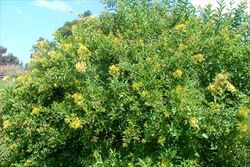
infestation (Photo: Sheldon Navie)
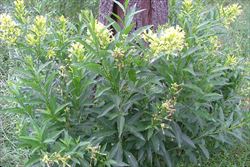
habit (Photo: Sheldon Navie)
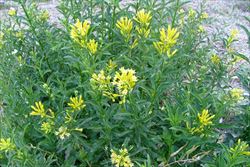
habit (Photo: Sheldon Navie)
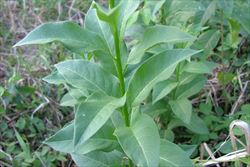
leaves (Photo: Sheldon Navie)
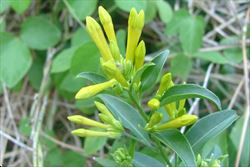
flower buds (Photo: Sheldon Navie)

flower cluster (Photo: Sheldon Navie)
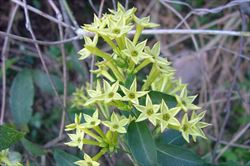
pale yellow flowers (Photo: Sheldon Navie)
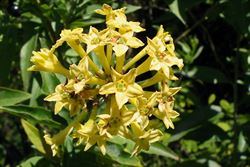
bright yellow flowers (Photo: Sheldon Navie)
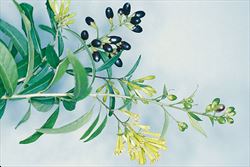
clusters of immature and mature fruit (Photo: Land Protection, QDNRW)
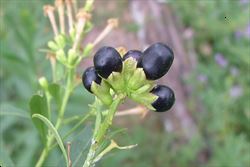
close-up of mature fruit (Photo: Sheldon Navie)
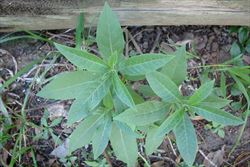
young plant growing from a root sucker (Photo: Sheldon Navie)
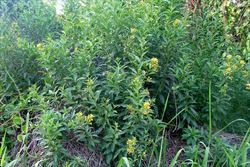
infestation (Photo: Sheldon Navie)
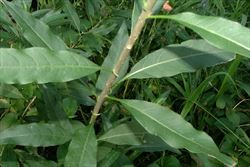
stem and alternately arranged leaves (Photo: Sheldon Navie)
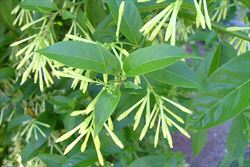
the very similar night jessamine (Cestrum nocturnum), with more slender pale yellow flowers (Photo: Sheldon Navie)
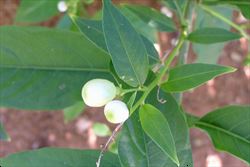
the white mature fruit of Cestrum nocturnum (Photo: Sheldon Navie)
Scientific Name
Cestrum parqui L’Hér.
Family
Solanaceae
Common Names
cestrum, Chilean cestrum, Chilean flowering jessamine, Chilean jessamine, green cestrum, green poison berry, green poison-berry, green poisonberry, iodine bush, willow jasmine, willow leaved jessamine, willow-leaf jessamine, willow-leaved jasmine, willow-leaved jessamine
Origin
Native to South America (i.e. Brazil, Bolivia, northern and central Chile, Peru, Paraguay, Uruguay and northern and central Argentina).
Cultivation
This species has been widely cultivated in gardens as an ornamental. Though it is no longer a popular garden plant, it may still be present in old gardens.
Naturalised Distribution
A very widespread species that is most common in the south-eastern and eastern parts of Australia. It is very common in the coastal and sub-coastal regions of southern Queensland and eastern New South Wales. Relatively common in Victoria and central Queensland and scattered in south-eastern South Australia. Also collected near Perth in south-western Western Australia, but this may be from cultivated plants.
Naturalised overseas in New Zealand and some parts of southern USA (i.e. California and Texas).
Habitat
A weed of warmer temperate and sub-tropical regions that invades the margins of watercourses (i.e. riparian habitats) and is also found in parks, old gardens, waste areas, disturbed sites, open woodlands, forest margins, pastures and along roadsides.
Habit
An upright (i.e. erect), much-branched, shrub usually growing 1-3 m tall, but occasionally reaching up to 5 m in height. It tends to form clumps and spread via suckers.
Distinguishing Features
- an upright and much-branched shrub (1-3 m tall) with stems and leaves that have an unpleasant odour when crushed.
- its alternately arranged leaves are somewhat elongated in shape with a pointed tip and wavy margins.
- its tubular flowers are borne in clusters and are yellow or yellowish-green in colour.
- these flowers are very elongated in shape (12-25 mm long and 3-5 mm wide) with with five triangular lobes (3-6 mm long) at their tips.
- its glossy black or purplish-black berries (10-15 mm long) are egg-shaped or oval in shape.
Stems and Leaves
The young shoots are often finely hairy (i.e. puberulent) and greenish in colour, while the newer stems are whitish and become hairless (i.e. glabrous) as the age. Older stems become woody and have a mottled grey appearance, and they sometimes also developed a striated bark at the base of mature plants.
The leaves are alternately arranged and are borne on short stalks (i.e. petioles) 3-12 mm long. The leaf blades (2-14 cm long and 5-40 mm wide) are narrowly egg-shaped in outline (i.e. narrowly ovate) or elongated (i.e. lanceolate) in shape. They are finely hairy (i.e. puberulent) when young, but become hairless (i.e. glabrous) as they mature. The leaves have a pointed tip (i.e. acute or acuminate apex) and their margins are entire, but often have a wavy (i.e. undulating) appearance. The stems and leaves of this species give off an unpleasant odour when crushed or bruised.
Flowers and Fruit
The flowers are borne in branched clusters at the tips of the branches (i.e. in terminal panicles). Each flower is borne on a very short stalk (i.e. pedicel) about 0.5 mm long (i.e. the flowers are sub-sessile). They have yellow or greenish-yellow petals (turning brownish-yellow with age) that are fused into a long tube (12-25 mm long and 3-5 mm wide) with five triangular lobes (3-6 mm long) at the tip. The flowers that are borne near the base of these clusters may have thin (i.e. linear) bracts below them. Flowering occurs throughout the year, but is particularly abundant during spring.
The fruit are egg-shaped (i.e. ovoid) or oval (i.e. ellipsoid) berries (10-15 mm long and 6-10 mm wide). These fruit are green when young and turn glossy black or purplish-black as they mature. Each berry contains a few prism-shaped seeds (3-4 mm long) that are dark green or brownish in colour.
Reproduction and Dispersal
This plant reproduces mostly by seed, but also spreads vegetatively via root suckers.
The seeds are mostly dispersed by birds and other animals, but are sometimes also spread by water or in dumped garden waste. It can also regenerate from root pieces that are dislodged during cultivation or roadside maintenance.
Environmental Impact
Green cestrum (Cestrum parqui) is regarded as significant environmental weed in New South Wales and Queensland. It is currently listed as a priority environmental weed in three Natural Resource Management regions, and is also regarded as a sleeper weed in other parts of the country. In New South Wales it is of most concern on the north coast and in the wider Sydney and Blue Mountains region. In Queensland it is listed in the top 100 invasive plants in the south-eastern part of the state. It is also scattered in bushland around Adelaide and causing some concern in the warmer regions of Victoria.
Green cestrum (Cestrum parqui) grows vigorously and has been known to outcompete other vegetation on alluvial floodplains in Queensland. It has also formed reasonably dense infestations along degraded creek-banks and in overgrazed pastures. As it can form extensive stands along the edges of forests and waterways, it replaces indigenous plants in these habitats and prevents their regeneration.
Other Impacts
The roots, stems, leaves and fruit of green cestrum (Cestrum parqui) are very toxic to livestock, domestic animals and humans, and stock losses have been reported.
Legislation
This species is declared under legislation in the following states and territories:
- New South Wales: Class 3 - a regionally controlled weed. The relevant local control authority must be promptly notified of the presence of this weed and it must be fully and continuously suppressed and destroyed (in a majority of local authority areas). See the New South Wales Department of Primary Industries Noxious Weeds List at http://www.dpi.nsw.gov.au for more detailed information on which local areas are covered in these declarations.
- Victoria: P3 - a prohibited weed that must be eradicated or controlled on land in the Goulburn, North East and East Gippsland regions, and C1 - a regionally controlled weed meaning landholders must take all reasonable steps to control it and prevent its spread on their land and the roadsides which adjoin their land (only in the shire of Northern Grampians in the Wimmera region).
- Western Australia: Prohibited - on the prohibited species list and not permitted entry into the state.
Management
For information on the management of this species see the following resources:
- the Biosecurity Queensland Fact Sheet on this species, which is available online at http://www.dpi.qld.gov.au.
Similar Species
Green cestrum (Cestrum parqui) may sometimes be confused with orange cestrum (Cestrum aurantiacum), night jessamine (Cestrum nocturnum) and red cestrum (Cestrum elegans). It also has similar flowers to tree tobacco (Nicotiana glauca). These species can be distinguished by the following differences:
- green cestrum (Cestrum parqui) has yellow or greenish-yellow flowers and black or purplish-black fleshy berries.
- orange cestrum (Cestrum aurantiacum) has orange or orange-yellow flowers and whitish fleshy berries.
- night jessamine (Cestrum nocturnum) has pale yellow or greenish-yellow flowers and whitish fleshy berries.
- red cestrum (Cestrum elegans) has pink or reddish flowers and dull red fleshy berries.
- tree tobacco (Nicotiana glauca) has yellow flowers and dry capsules that split open when mature.
It may also be confused with some native plants when not in flower. However, its leaves give off a distinctive unpleasant odour when crushed.

